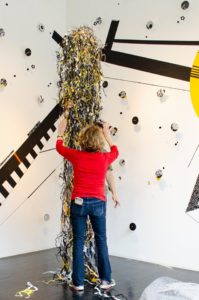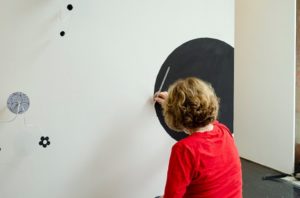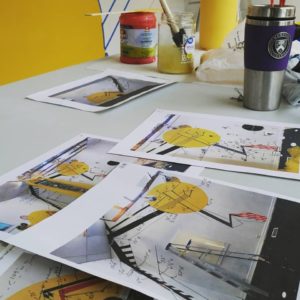June 17, 2019
The ShortNorth.org blog highlights the happenings of the Short North Arts District. In Art Spotlight, we feature the artists, gallerists, performers, and professional companies of the District and explore their exhibitions, shows, and more.
This week, we talked to Hammond Harkins Galleries artist Karen Snouffer about her latest exhibition, Divine Connections.
 This show has been described as an imaginary garden with vines representing growth, outreach, and connection. Where did the inspiration for this exhibition come from? Does the inclusion of the word “divine” have any religious/spiritual reference, such as to the Garden of Eden? If not, what is the “divine” connection being made?
This show has been described as an imaginary garden with vines representing growth, outreach, and connection. Where did the inspiration for this exhibition come from? Does the inclusion of the word “divine” have any religious/spiritual reference, such as to the Garden of Eden? If not, what is the “divine” connection being made?
I have used the vine as a symbolic object in my work for several years. Because a great deal of my work is grounded in drawing, I see the vine as complex and multi-layered, very much like a gesture drawing. Nature is a frequent source of inspiration, and since I live in a rural area, I repeatedly observe fascinating moments of chaos and order in the natural world. I have a clematis vine that grows each year on a pergola in front of our house, and as I tie it up and trim it each spring, trying to keep up with its rapid growth, I feel as though I am grappling with an entangled force of life that has intense energy and beauty, even in its unpredictable, chaotic directions. It is a yearly ritual that reminds me of the power of growth and the unknown. I love handling the vines and arranging them to grow upward, yet they will take their own direction each day. Their fragrant blooms in late August are a payoff of great beauty.
I chose the word “divine” as a play on the word “vine,” and even though is it is not a religious reference, I do feel that observing nature and making art offer me spiritual moments. The theme of connections has many meanings here: my relationships with others; tongue-in-cheek playfulness with the serious; and, on a formal level, between parts of the installation, such as the natural with the artificial, the organic with the geometric, and the flat elements with the spatial ones.
This work has an emphasis on joy and play. Because I have made more somber work in the past and I have experienced debilitating depression, as well as the fact that so many aspects of our social and political climates are very sobering now, I felt a need to make a contradicting, uplifting statement.
 Part of Divine Connections is a site-specific installation that saw you painting the walls in addition to hanging work on them and throughout the gallery. What was your process for planning the installation portion of the exhibit? How does having a site-specific installation help to connect the viewer/visitor to the experience of seeing the work?
Part of Divine Connections is a site-specific installation that saw you painting the walls in addition to hanging work on them and throughout the gallery. What was your process for planning the installation portion of the exhibit? How does having a site-specific installation help to connect the viewer/visitor to the experience of seeing the work?
My process is to develop the installation first in my studio as close to the final product as possible. It feels very much like rehearsing for a performance. I was an improv dancer for years, so I think an innate understanding of space and the body in it are integral to my process and imagery. I knew I wanted to create an environment that would cause the viewer to immediately react to the large-scale imagery then to explore the details within. A site specific installation such a Divine Connections allows the visitor to have a physical relationship to the work and to discover intimate intricacies, then to draw a conclusion as to what it means for them. Also, I see the work is a form of reductionist art, that is, one that verges on the non-real, more abstract aesthetic and forces the viewer to actively use their imagination.
As expressed in your artist statement, you embrace tension that arises from contrasting forces, particularly, recently, chaos and order. What kind(s) of tension(s) did you encounter while making pieces for Divine Connections? Were chaos and order among them, and if so, what patterns did you find? Did you experience an “edge of chaos” moment with the work in this exhibit?
Every artist I know experiences tension when preparing for a show, as well as on those days when they are not sure what will happen in the studio, when they feel an anxiety about confronting a canvas or piles of wood or a computer screen or whatever materials are their chosen media.
Regarding my installation process, it is full of tension, since it is not until the I install the show that I really know how it will look and if I am happy with it. I like the excitement in the presence of these unknowns while I work. The making of objects from various materials can feel very chaotic, since I surround myself with all kinds of cool and stimulating materials, but am not sure if I can make them work together in a compelling manner. At those moments, I feel overwhelmed in the middle of chaos. The pattern and order start to develop once I have solved a technical and visual unknown, which can take days or weeks for just one element of the installation. As an example, I might have to solve, “What materials and what design do I use to make repeated forms project from the wall and cast shadows while looking like parts are floating?”
The “edge of chaos” comes for me when I feel overcome by so many parts, as though they are dangling, unresolved and disconnected, but I am determined (while at times, exhausted) to figure out the answers.
 Your artist statement indicates using mixed media is an important part of your artistic expression because it gives you more freedom and options; how did you choose the materials for this exhibit to help express your ideas?
Your artist statement indicates using mixed media is an important part of your artistic expression because it gives you more freedom and options; how did you choose the materials for this exhibit to help express your ideas?
I like using common, “low brow” materials in a sophisticated manner, in treatments that one would not think of using for say, a pom pom or glitter, and merging them with traditional treatments in wood, ink, and paint. I am making the statement that artists can use these craft materials to make unique and beautiful objects, even odd and strange ones, and that there is no hierarchy of materials in contemporary art. I also like juxtaposing materials such as foam and plastic sheeting with complicated drawing and painting techniques, to achieve depth and layers. I use materials that have some longevity, so that I may utilize the objects again in other venues.
How did your relationship/representation with Hammond Harkins Galleries begin? What does it mean to you, as an artist, to be able to be represented by, and show in, a gallery that is part of an arts district?
I made a connection with the gallery eight years ago when it was located on Main Street in Bexley. Marlana Hammond and her staff supported me at once with impressive professionalism and kindness. Even though my aesthetic was different from the present, I was doing wall drawing installations and making collage works as I am now. I feel fortunate to be represented by such a respectable gallery, as there are so many strong artists practicing in this region who need gallery representation. Showing my work, especially an installation, in the Short North, is an exciting experience. I am sure that the palpable energy present in this neighborhood has had an impact on the art I am making and exhibiting.

